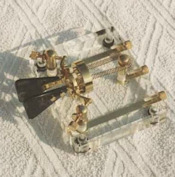CW (Contineous Wave) or Morse code
My preferred mode on HF has always been CW (morse code)!
Despite the fact that some people think that CW is practically dead, it was the mode that interested me most since the beginning so, with the exception of some demonstrations, all QSO's on HF have been made exclusively in CW. And again, my father came to help with his talents. In his free time at home, he made a very nice paddle in shining brass, allowing me to go to higher CW-speeds above the limitations of the classical hand key.
(If you click on the picture, you will get larger pictures of this superb demonstration of handicraft.)
Jim Hatherly, known as WA1TBY, wrote a beautifull poem on CW in 1985. Click here to read it.
A short biography of Samuel Morse and some pictures can be found here.
A typical call for contact is made by the following message : 'CQ de ON4CAY, pse k', in which some parts are repeated to make it more easy to understand who is calling. In the message, CQ stands for 'seek you', pse stands for 'please' and k stands for 'come'.
You can use this audio player to hear what it sounds like :
Learning the international Morse code might seem difficult, but it is just a matter of practise. Instead of recognizing visually the shape of a letter, number or punctuation mark, one has to learn to assign a certain rithm with a letter, so you might call it an audible way of reading.
| .- | a | .... | h | --- | o | ...- | v | |||||||||||||||||||||||||
| -... | b | .. | i | .--. | p | .-- | w | |||||||||||||||||||||||||
| -.-. | c | .--- | j | --.- | q | -..- | x | |||||||||||||||||||||||||
| -.. | d | -.- | k | .-. | r | -.-- | y | |||||||||||||||||||||||||
| . | e | .-.. | l | ... | s | --.. | z | |||||||||||||||||||||||||
| ..-. | f | -- | m | - | t | |||||||||||||||||||||||||||
| --. | g | -. | n | ..- | u | |||||||||||||||||||||||||||
| ---- | 0 | .---- | 1 | ..--- | 2 | ...-- | 3 | |||||||||||||||||||||||||
| ....- | 4 | ..... | 5 | -.... | 6 | --... | 7 | |||||||||||||||||||||||||
| ---.. | 8 | ----. | 9 | |||||||||||||||||||||||||||||
| .-.-.- | . | --..-- | , | ..--.. | ? | -..-. | / | |||||||||||||||||||||||||
| -...- | = | -....- | - | -.--. | ( | -.--.- | ) |
A series of at least 8 dots (........) indicates an error and the last word is sent again.
In order to keep the message as short as possible, a lot of abbreviations are used in Morse traffic. Information on these abbreviations and the widely used Q-code can be found on numereous pages on the Internet and can easily be found with any search engine.
